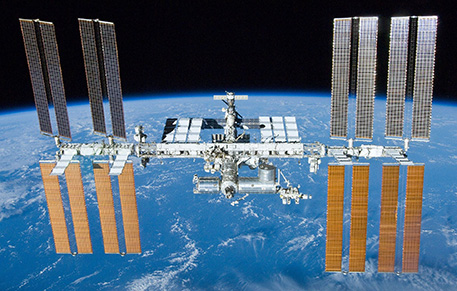
FAYETTEVILLE, Ark. — Two University of Arkansas researchers working on a promising new material to create more efficient solar cells will lead a corps of Arkansas scientists chosen to develop the next generation of photovoltaic devices used in space missions.
Shui-Qing “Fisher” Yu, associate professor of electrical engineering, will serve as principal scientific investigator on the multi-institutional project. The team will develop photovoltaic devices made of silicon-germanium-tin, a powerful semiconductor that has been proven to increase efficiency in electronic devices that source, detect and control light.
The project is made possible by a $750,000 NASA/EPSCoR grant to the Arkansas Space Grant Consortium Office at the University of Arkansas at Little Rock. EPSCoR — Experimental Program to Stimulate Competitive Research — is a funding program to increase state participation in competitive aerospace-related research activities.
“We are excited that our material research has been recognized by NASA,” Yu said. “Now we have the opportunity to move forward developing a high-performance solar cell for space applications.”
Yu will collaborate with Hameed Naseem, professor of electrical engineering; Mansour Mortazavi, physics professor at the University of Arkansas at Pine Bluff; and Allan Thomas, physics professor at the University of Arkansas at Little Rock. Yu, Naseem and Mortazavi previously received a $725,000 grant from the U.S. Air Force Office of Scientific Research to work on similar technology.
For the NASA project, the researchers will capitalize on their already extensive investigation of silicon-germanium-tin to develop photovoltaic devices that can be integrated into existing solar cells to achieve a more efficient, optimal energy yield. Current, “triple junction” photovoltaic technology used by NASA has reached its efficiency limit. The new material is intended to boost performance, helping NASA achieve its 15-year, 45-percent efficiency goal for solar devices. The new material should also lower the cost of manufacturing and make the devices more radiation tolerant.
The research plan includes device design and simulation, material growth and characterization, optical characterization of silicon-germanium-tin materials, and development of silicon-germanium-tin photoconductors.
The researchers grow and characterize silicon-germanium-tin materials on silicon substrates through a process called ultra-high-vacuum chemical vapor deposition, made possible by sophisticated equipment and machines in laboratories directed by Yu and Naseem.
Related to this research, Yu has also received a $96,455 grant from the U.S. Army Research Office to upgrade equipment used to characterize silicon-germanium-tin-based devices.
About the University of Arkansas: The University of Arkansas provides an internationally competitive education for undergraduate and graduate students in more than 200 academic programs. The university contributes new knowledge, economic development, basic and applied research, and creative activity while also providing service to academic and professional disciplines. The Carnegie Foundation classifies the University of Arkansas among only 2 percent of universities in America that have the highest level of research activity. U.S. News & World Report ranks the University of Arkansas among its top American public research universities. Founded in 1871, the University of Arkansas comprises 10 colleges and schools and maintains a low student-to-faculty ratio that promotes personal attention and close mentoring.
Contacts
Shui-Qing “Fisher” Yu, associate professor, electrical engineering
College of Engineering
479-575-7265 , syu@uark.edu
Matt McGowan, science and research communications officer
University Relations
479-575-4246, dmcgowa@uark.edu